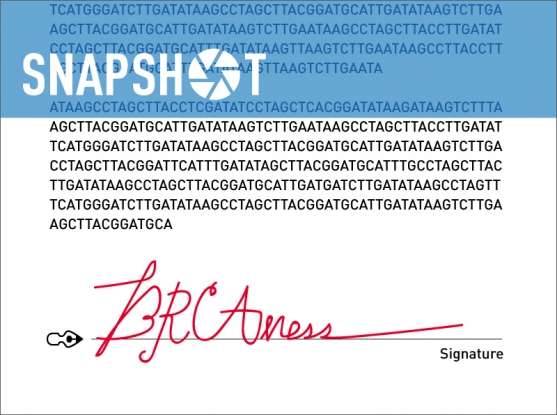Searching for the 'signature' causes of BRCAness in breast cancer

Breast cancer cells with defects in the DNA damage repair-genes BRCA1 and BRCA2 have a mutational signature (a pattern of base swaps—e.g., Ts for Gs, Cs for As—throughout a genome) known in cancer genomics as "Signature 3." But not all breast tumor cells exhibiting Signature 3 have BRCA1 or BRCA2 mutations. Therefore, some consider Signature 3 a biomarker for "BRCAness," a sign of a breakdown in BRCA-related DNA repair (a process called homologous recombination, or HR) in general and not BRCA damage in particular.
The question is, what else might deactivate HR and give rise to Signature 3? And beyond that, might Signature 3 have a role in the clinic?
To find out, an international team led by Paz Polak, Jaegil Kim, Lior Braunstein, and Gad Getz of the Broad Institute's Cancer Program and William Foulkes of McGill University reanalyzed data from nearly 1,000 breast cancer tumors collected by The Cancer Genome Atlas (TCGA). Their findings, reported in Nature Genetics, hint that mutational signatures like Signature 3 might fuel a precision medicine approach that uses a tumor's full scope of mutations to guide risk and treatment decisions, instead of focusing on individual genes.
Among the breast tumors exhibiting Signature 3, the researchers found that:
- Tumors with germline (inherited) or somatic (acquired) BRCA1 or BRCA2 mutations were overwhelmingly positive for Signature 3. So too were tumors with germline mutations in PALB2, a gene that works in concert with BRCA1 and BRCA2.
- Defects in ATM or CHEK2 (two genes that alert the cell to DNA damage, and which can harbor breast cancer risk-raising germline variants) were not linked to Signature 3.
- Expression of RAD51C (another BRCA1/2 partner) was epigenetically blocked in several tumors. This hitherto-unrecognized HR dysfunction mechanism was far more common in basal-like breast tumors from younger African-American women in the dataset than in those from white women, as was epigenetic BRCA1 silencing (a known Signature 3 driver). The reverse was true for mutation-based drivers.
And what of Signature 3's clinical utility? The team found that they could combine the signature's presence or absence in breast cancer cells with other data to classify rare BRCA1 and BRCA2 mutations as harmful or not, a finding they noted needs to be investigated further. The researchers also suggested that Signature 3 might one day factor into treatment decisions for women with breast cancer, or help guide development of future "BRCAness"-targeting therapies.
More information: Paz Polak et al. A mutational signature reveals alterations underlying deficient homologous recombination repair in breast cancer, Nature Genetics (2017). DOI: 10.1038/ng.3934

















